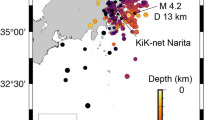Abstract
Surface wave exploration has the advantages of high shallow resolution, small site limitations, and convenient construction, increasing its use in near-surface exploration. Dispersion curve inversion is an important step in surface wave exploration and is directly related to the acquisition of underground formation information. Similar to numerous geophysical inversion problems, dispersion curve inversion has multiparameter and multiextreme characteristics and is difficult to solve using a linear method. In this paper, a new dispersion curve inversion method based on the Archimedes optimization algorithm (AOA), namely the improved AOA (IAOA), is proposed. IAOA optimizes the population initialization based on AOA and adds the capability to automatically balance global search and local development performance in the iteration process, which enriches the population information in the later stage of AOA iteration. The algorithm is used to invert the noise and noise-free base-step scatter curves of the three theoretical models to test the performance of IAOA for dispersion curve inversion. In the inversion test of the theoretical model of noise-free data, the particle swarm optimization (PSO) algorithm and AOA were also tested in the same inversion test to compare the performances of the PSO, AOA, and IAOA algorithms. The results of the model test revealed that IAOA can stably and quickly converge to the optimal solution, and the inversion results have strong credibility, good noise immunity, and can be effectively used for dispersion curve inversion. Finally, the measured data from the Wyoming area of the United States were utilized to test the capability of IAOA to invert actual data. The inversion results indicated that IAOA has strong practicability and can obtain effective formation information.
Similar content being viewed by others
References
Chen, J., He, Q., and Li, S. Y., 2022, Archimedes optimization algorithm based on adaptive feedback adjustment factor: Computer Science, 49(8), 237–246.
Chen, J., He, Q., and Li, S. Y., 2022, Archimedes optimization algorithm based on golden levy guidance mechanism: Journal of Computer Applications, 42(9), 2807–2815.
Cai, W., Song, X. H., Yuan, S. C., and Hu, Y., 2018, Inversion of Rayleigh wave dispersion curves based on firely and bat algorithms: Chinese Journal of Geophysics, 61(06), 2409–2420.
Dorman, J., and Ewing, M., 1962, Numerical inversion of seismic surface wave dispersion data and crust-mantle structure in the New York-Pennsylvania area: Journal of Geophysical Research, 67(13), 5227–5241.
Fan, H. Y., Liu, J. Q., and Xiao, B. X., 2002, Fast vector-transfer algorithm for computation of Rayleigh wave dispersion curves: Journal of Hunan University(Natural Sciences Edition), 29(5), 25–30.
Gong, S. J., 2008, Prospecting and application of transient ground roll: Coal Geology of China, 20(S1), 84–86.
Hashim, F. A., Hunssain, K., Houssein, E. H., et al., 2021, Archimedes optimization algorithm: a new metaheuristic algorithm for solving optimization problems: Applied Intelligence, 51(3), 1531–1551.
Hou, Z., 2013, Nonlinear joint inversion algorithm research of DC resistivity and Rayleigh wave seismic: PHD Thesis, China University of Geosciences, Beijng.
Jiang, N. L., 2021, Research on short-term power load foreceasting based on improved sparrow search algorithm to optimize long short-term memory network: MA Thesis, Nanchang University.
Luo, S. H., and He, Q., 2021, Improved archinmedes optimization algorithm by multi-strategy collaborative and its application: Application Research of Computers, 39(5), 1386–1394.
Liu, Y. Z., 2018, Practical seismic wave exploration technology: Institute of Geophysical Prospecting of Beijing.
Rayleigh, L., 1885, On waves propagated along the plane surface of an elastic solid: Proceedings of the London Mathematical Socity, 1(1), 4–11.
Song, X., Tang, L., Lv, X., et al., 2012, Application of particle swarm optimization to interpret Rayleigh wave dispersion curves: Journal of Applied Geophysics, 84, 1–13.
Shen, H. Y., Wang, X., and Li, X. X., 2019, Near-surface structure survey and parameter inversion review: Geophysical Prospecting for Petroleum, 58(4), 471–485.
Shi, Y. L., and Jin, W., 1995, Genetic algorithms inversion of lithospheric structure from surface wave dispersion: Chinese Journal of Geophysics, 38(02), 189–198.
Wu, D. S., Sun, C. Y., and Lin, M. Y., 2017, Activeseismic surface wave dispersion imaging method based on cross-correlation and phase-shifting: Progress in Geophyics, 32(04), 1693–1700.
Xia, J., Miller, R. D., and Park, C. B., 1999, Estimation of near-surface shear-wave velocity by inversion of Rayleigh waves: Geophysics, 64(3), 1390–1395.
Xia, J., 2014, Estimation of near-surface shear-wave velocities and quality factors using multichannel analysis of surface-wave methods: Journal of Applied Geophysics, 103, 140–151.
Zhang, Z. H., 2003, Application of Rayleigh surface wave exploration in cavity detection: Hunan Hydro & Power, (1), 19–20.
Zhang, S. X., and Chan, L. S., 2003, Possible effects of misidentified mode number on Rayleigh wave inversion: Journal of Applied Geophysics, 53(1), 17–29.
Acknowledgments
This work was financially sponsored by the National Natural Science Foundation of China (42004113, 41904044), National Science and Technology Supporting Program of Jiangxi Province (20212BAB211003, 20212BBG73011), and the Jiangxi University Students Innovation and Entrepreneurship Project (S202210405012, S202210405016).
Author information
Authors and Affiliations
Corresponding author
Additional information
Author Profile: Zhenan Yao, male, PhD, associate professor, master supervisor, graduated from China University of Petroleum (East China) with a doctoral degree in geological resources and geological engineering in 2018 and now works at East China University of Technology, mainly engaged in scientific research and teaching of seismic exploration. Email: an6428060@163.com
Supported Projects: This work was sponsored by National Natural Science Foundation of China (42004113, 41904044), National Science and Technology Supporting Program of Jiangxi Province (20212BAB211003, 20212BBG73011), And the Jiangxi University Students Innovation and Entrepreneurship Project (S202210405012, S202210405016).
Rights and permissions
About this article
Cite this article
Yao, ZA., Wang, R., Yu, F. et al. Rayleigh surface wave inversion based on an improved Archimedes optimization algorithm. Appl. Geophys. (2023). https://doi.org/10.1007/s11770-023-1010-6
Received:
Revised:
Published:
DOI: https://doi.org/10.1007/s11770-023-1010-6




